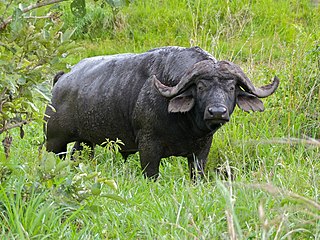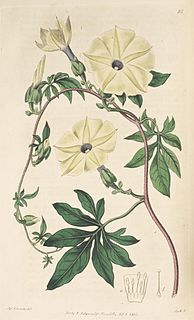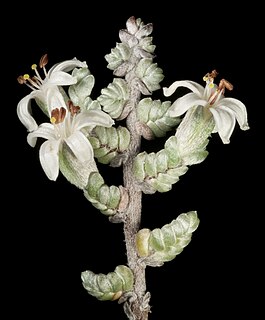
The biological subfamily Bovinae includes a diverse group of 10 genera of medium to large-sized ungulates, including domestic cattle, bison, African buffalo, the water buffalo, the yak, and the four-horned and spiral-horned antelopes. The evolutionary relationship between the members of the group is still debated, and their classification into loose tribes rather than formal subgroups reflects this uncertainty. General characteristics include cloven hooves and usually at least one of the sexes of a species having true horns. The largest extant bovine is the gaur.

The Nymphalidae are the largest family of butterflies with more than 6,000 species distributed throughout most of the world, belonging to the superfamily Papilionoidea. These are usually medium-sized to large butterflies. Most species have a reduced pair of forelegs and many hold their colourful wings flat when resting. They are also called brush-footed butterflies or four-footed butterflies, because they are known to stand on only four legs while the other two are curled up; in some species, these forelegs have a brush-like set of hairs, which gives this family its other common name. Many species are brightly coloured and include popular species such as the emperors, monarch butterfly, admirals, tortoiseshells, and fritillaries. However, the under wings are, in contrast, often dull and in some species look remarkably like dead leaves, or are much paler, producing a cryptic effect that helps the butterflies blend into their surroundings.

The Lacertidae are the family of the wall lizards, true lizards, or sometimes simply lacertas, which are native to Europe, Africa, and Asia. The group includes the genus Lacerta, which contains some of the most commonly seen lizard species in Europe. It is a diverse family with at least 300 species in 39 genera.

Ipomoea is the largest genus in the flowering plant family Convolvulaceae, with over 500 species. It is a large and diverse group with common names including morning glory, water convolvulus or kangkung, sweet potato, bindweed, moonflower, etc.

Calystegia is a genus of about 25 species of flowering plants in the bindweed family Convolvulaceae. The genus has a cosmopolitan distribution in temperate and subtropical regions, but with half of the species endemic to California. They are annual or herbaceous perennial twining vines growing to 1–5 m tall, with spirally arranged leaves. The flowers are trumpet-shaped, 3–10 cm diameter, white or pink, with a sometimes inflated basal epicalyx.

Ipomoea tuberculata is a flowering plant species in the bindweed family (Convolvulaceae). It belongs to the morning glory genus, Ipomoea.

The Ourapterygini are one of the large tribes of geometer moths in the subfamily Ennominae. The tribe was described by Charles Théophile Bruand d'Uzelle in 1846. They are particularly plentiful in the Neotropics. Ourapterygini are generally held to be the youngest tribe of their subfamily, and at least seasonally have characteristic apomorphic asymmetrical processes of the anellus.

Phyllostominae is a subfamily of bats.
Ipomoea abrupta is a species of plant in the Convolvulaceae family of the genus Ipomoea. It is endemic to Western Australia.

Ipomoea aristolochiaefolia is a species of plant in the Convolvulaceae family of the genus Ipomoea. It is endemic to parts of South America.

Ipomoea asarifolia, the ginger-leaf morning-glory, is a species of plant in the Convolvulaceae family, of the genus Ipomoea.

The Catostomidae are the suckers of the order Cypriniformes, with about 78 species in this family of freshwater fishes. The Catostomidae are primarily native to North America, but Catostomus catostomus is found in both North America and Russia, and Myxocyprinus asiaticus is from China. In the Ozarks they are a common food fish and a festival is held each year to celebrate them.

Wilsonia is a genus of perennial subshrubs in the family Convolvulaceae. The genus is endemic to Australia, occurring in coastal saltmarshes and occasionally in inland saline areas.

Ipomoea leptophylla, the bush morning glory, bush moonflower or manroot, is a flowering plant species in the bindweed family, Convolvulaceae.
Simon Jan van Ooststroom was a Dutch botanist.

The Dinidoridae are a small family of insects comprising about a hundred species in sixteen genera in the Hemipteran suborder Heteroptera, the "true bugs". As a group the family does not have any common name. Until the late 19th century they were generally regarded as a subfamily of the Pentatomidae.
Jacques Denys (Denis) Choisy was a Swiss Protestant clergyman and botanist.
Xenicomorpha is a genus of beetle belonging to the leaf beetle family, Chrysomelidae. Both the larvae and the adults (imago) are herbivores.
















